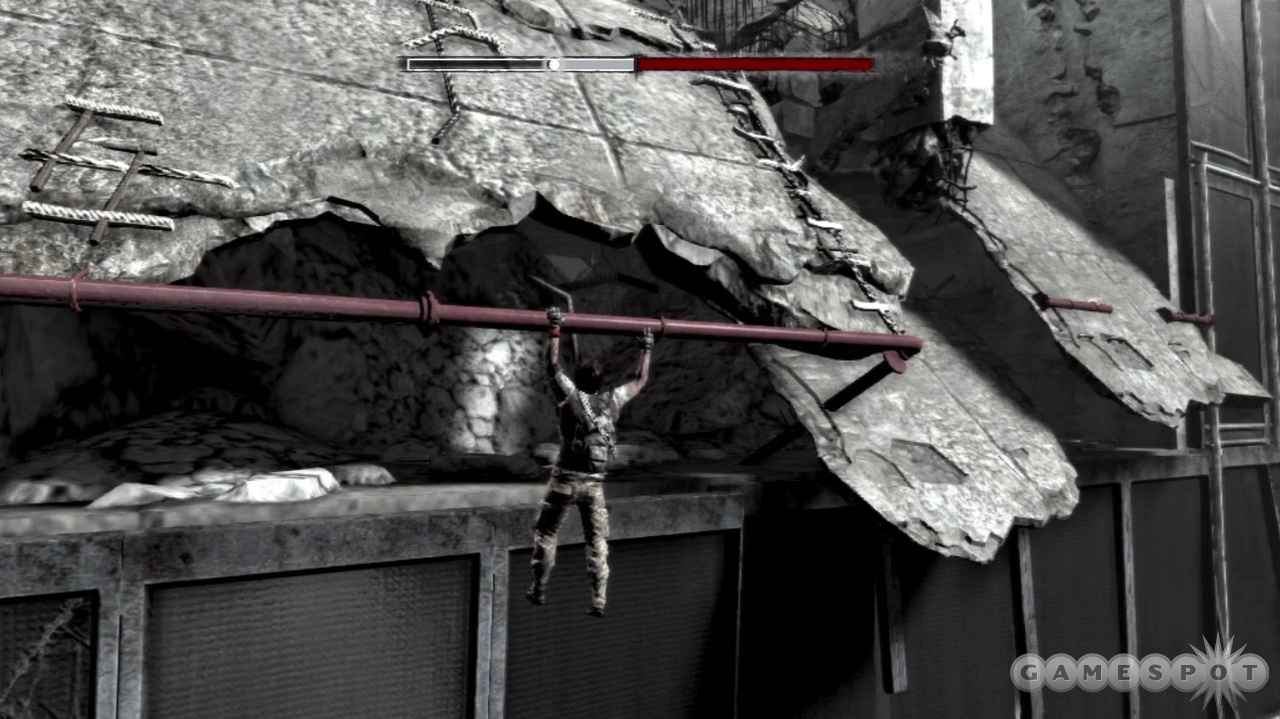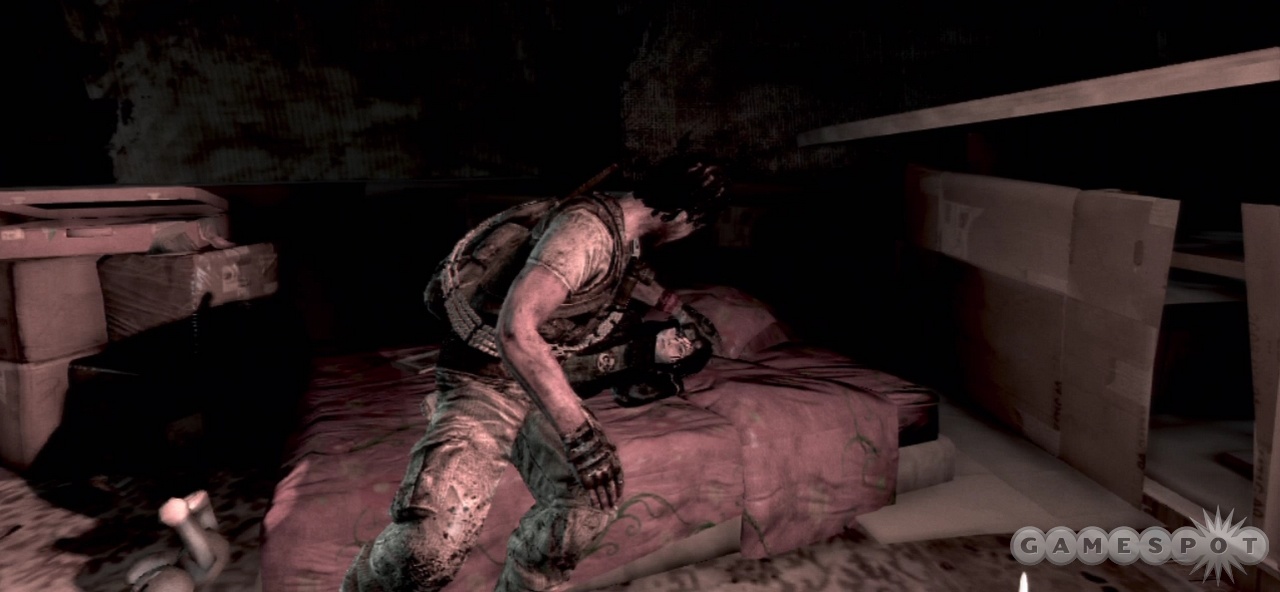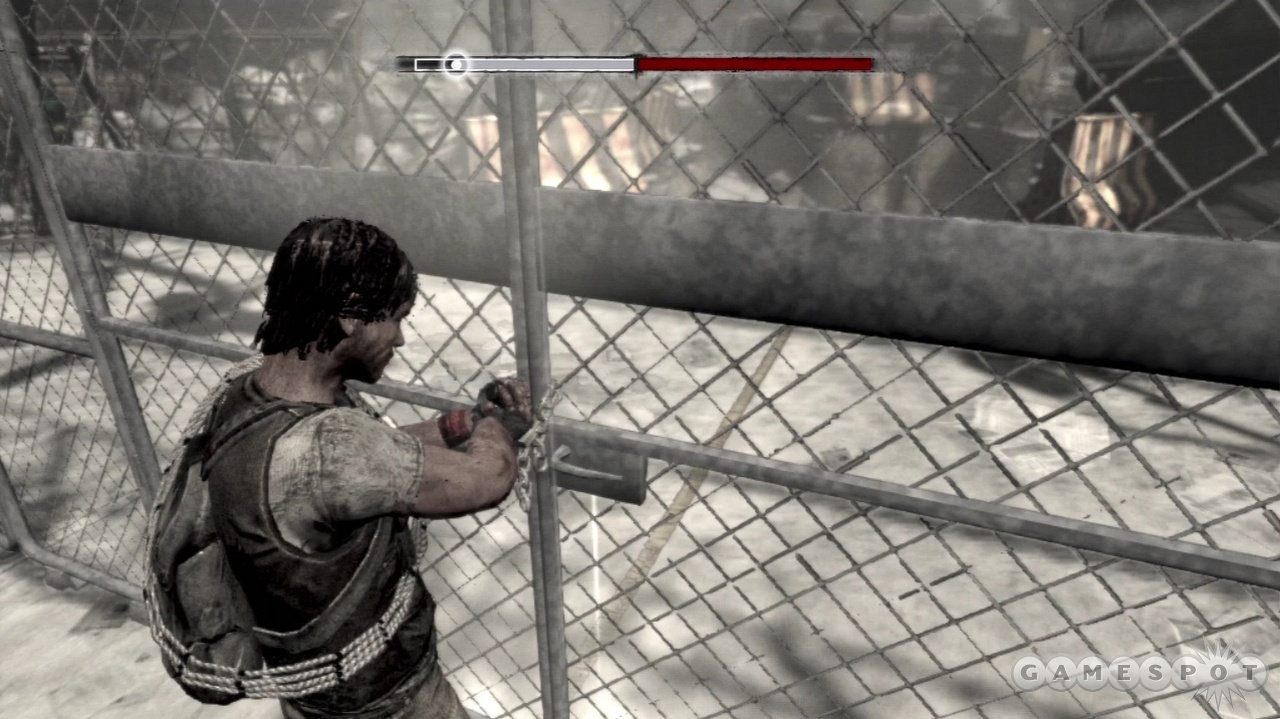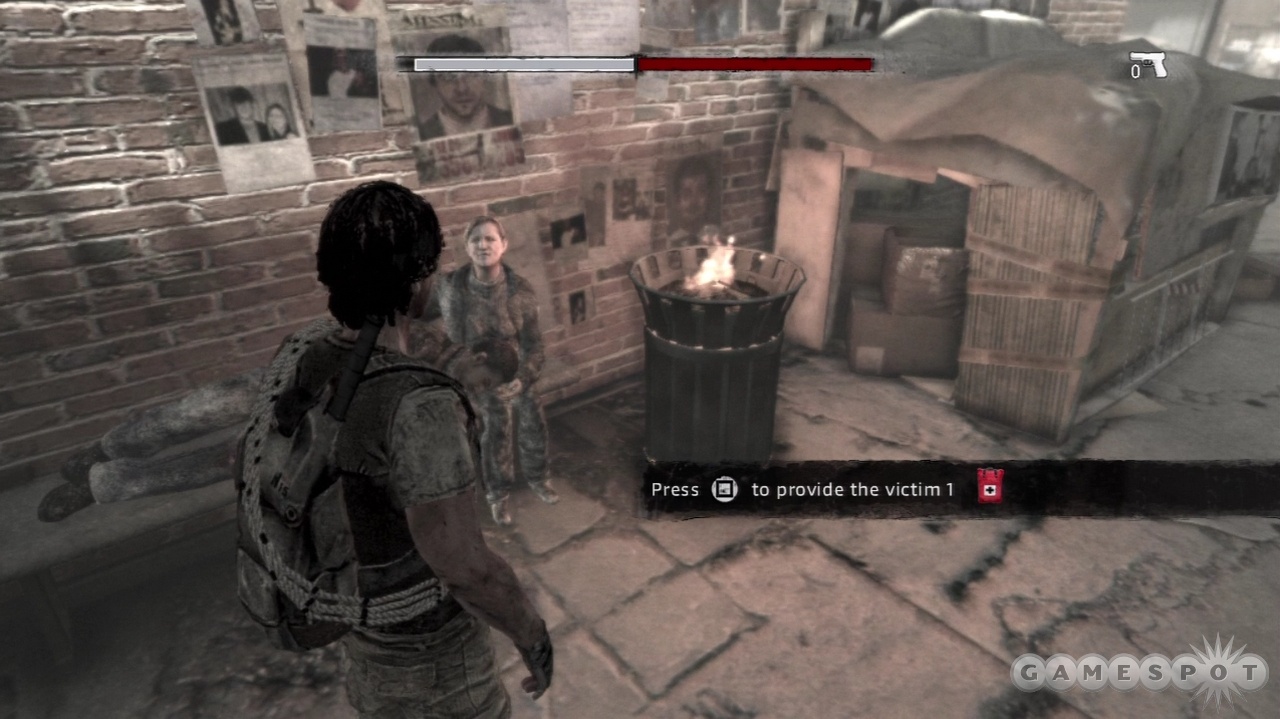Your city is in ruins. Destroyed cars litter the decimated streets and lie dormant beside the crumbling buildings that struggle to rise above the twisted train tracks. Dust swirls and cloaks, choking anyone unfortunate enough to be caught in its suffocating gusts. And the people are in even worse shape than the tattered city they still call home. Society has disintegrated as quickly as the structures that used to cage in its residents. Some people travel in wolfish packs, scrounging on the weak to feed their insatiable desires. Others huddle with their loved ones, thankful just to survive another day. How will you react in this bleak world? I Am Alive effectively conveys the broken state of society when devastation hits and no police force exists to keep order. There is no good or bad here, just alive or dead, and the tough decisions you make to keep breathing ensure I Am Alive's emotional depth.
The protagonist is an unnamed man in search of his family. On the surface, the decision to leave the main character nameless seems strange, especially when the supporting cast members all have a moniker to call their own. But it makes sense when you consider the purpose of this survival-themed adventure. Through difficult decisions and a constant feeling of dread, you are the main character in I Am Alive. By painting only a cursory character in the starring role--determined, loyal, loving--and leaving the rest of his details unstated, I Am Alive immediately draws you into this world and establishes that you, not a digital construct, have to make the tough choices.
When the event hit, you were on the other side of the country. Four hours to fly across the country, almost a year to walk back home. But your family needs you. Hints of betrayal, where you somehow let down your kin at some point in the past, are touched on and make you wonder what unforgivable act was committed to bear such a terrible penance. Like most of the details, you never find out exactly why the main character is struggling with guilt. It's never explained what "the event" entailed, either. Was it an attack by a foreign nation? Homegrown terrorism? Natural disaster? It's left to your imagination, but the cause isn't important. Only the effect. And when he arrives at his apartment, long since abandoned, with no clue as to where his family has disappeared or if they're even alive, you care.

That bond is further strengthened by the appearance of a young girl. Mei is surrounded in a parking lot by angry men with bad intentions. She's alone, scared, and looks strikingly like your own daughter. In a flurry of violence, you slay those men because doing nothing would have made it impossible to live with yourself. Mei begins to trust you. Her mother has gone missing, and your protective instincts take over. Tied to your back, you carry her through the desolate remains. You establish an immediate connection with Mei because she's helpless, sweet, and doesn't deserve to live in this terrible world. She can't even remember what the city was like before the event hit. When she develops a fever, you rush to find medicine--it's an objective you must complete, but you need no encouragement. She's your only companion and your closest connection to your own family, so you do everything in your power to keep her safe.
Story details are kept to a minimum. Instead of pulling you out of the action with long cutscenes, most of the information is conveyed as you walk through this wasteland. At one point, you come across a group of survivors huddled together by a roaring fire in the heart of the subway. They see Mei on your back, tired and hungry, and they offer you some meat. You greedily accept their present because a piece of meat replenishes most of your health and stamina in one bite.
As you survey their camp, you come across a cage that is now filled with bones. Dog? Cat? Human? You can only wonder what sort of meat was handed to you. Later on, you find a starving, desperate woman struggling to carry onward. When you hand her a can of fruit, she shows her thanks and you feel good for saving someone in need. Walk by her position later, you find her hanging from a noose. You didn't need to go back, but you wanted to see how she was doing, and now you can't get that image out of your head.

With direct routes destroyed by the event, you have to climb to get to new areas. You go up drain pipes, across rails, and down ladders as you take hold of anything that supports your weight. As soon as you grab on to a ledge, your stamina drops, and the pounding music solidifies the idea that time is running out. You're not superhuman, just a regular man, and you will die if you run out of strength. So you move as quickly and precisely as possible. Your limited reserve of items can be used to recharge your stamina in a pinch, but each morsel is precious. You have to make your resources last, which tinges every climb with the pressure of failure. If you press too far and let your stamina go below its breaking point, it won't regenerate fully when you step back on solid ground. There's permanence to your actions in I Am Alive that makes everything you do take on added importance.
When you aren't clinging frantically to the side of a wall, you weave through the chaos of your new reality. Although you only travel through a small part of the city in I Am Alive, it feels like an entire world. The devastation cuts off the quickest path to your destination, so finding out how to get where you want to go takes patience and determination. On the street, a poisonous fog continually saps your stamina, so you have to find ways to rise above the cloud. If you climb up to a fire escape to catch your breath, you can survey the landscape. You may walk in the wrong direction for minutes at a time, trying to find a way to cross seemingly impassable obstacles. There's a feeling of dread that permeates all of your choices. If you go off to the wrong place, you might not be able to climb to clean air. You might die on the street. So your heart races, but you press on and hope that you don't get caught in the fog.
There are times when the illusion is tarnished. You walk down an alley and the game boldly warns you that you're going the wrong way. Getting completely lost is difficult, given that you have a map you can access anytime, so such hand-holding is unnecessary. An intrusive heads-up display also strips away some of the realism. A giant red and white bar stretches across the top of the screen at all times, giving constant updates of your health and stamina. Handy? Yes. But there could have been a more elegant way to handle such concerns. I Am Alive is so effective because it removes many artificial barriers and forces you to make intimate and emotional decisions. The few unrealistic elements are a stark contrast to the engrossing world and only lessen the experience.
Such concerns won't matter when you're engaged in a tense fight for your life. Some people on the street want to attack you. They want to kill you. Aggression is a last resort for a man desperate to stay alive to see his family once more. So when you're approached by an armed thug, you hold up your arms instead of your gun. Slowly back away, try to calm him with your words, and lure him into thinking he has the upper hand. And then, when he lets his guard down, slit his throat with a quick slash from your knife. His companion will know you were playing possum. He rushes toward you, but you freeze him in his tracks with your gun. With sights aimed at his head, he doesn't realize the chamber is empty. You yell at him angrily and order him to back away. Steer him toward the fire and kick him into it. You've now killed two men and didn't have to waste any ammunition to do so.
Combat in I Am Alive is psychological. Because picking up one bullet feels like a bounty, you need to be smart and resourceful to stay alive. Reading the emotions of the aggressive survivors who are intent on your death is key if you want to make it through unscathed. When a group ambushes you amid the wreckage of a highway-turned-parking-lot, you need to immediately assess the situation. Who's armed? Do any of them have guns? Those are the most likely to cause you harm. But analysis goes deeper than that. There may be four or five attackers closing in, and you can't expect to kill that many with two bullets. So you listen to their words. You watch their actions. Who's weak? Who's following orders? And who's strong? If you can eliminate the leader, his subordinates surrender. Such mind games keep you on edge during every fight because you're never sure going in what mask your assailants wear.

Of course, there are people who don't want to kill you. Maybe they have their own stash of valuables to guard or their own loved ones to protect. When you approach them, they threaten you. They shout and yell, even pointing a weapon your way. But they don't want to fight. They just want to live. Keep on walking if you want. You're not a street thug, after all; just a desperate man in search of his family. But you can see a precious bottle of water just behind the man yelling frantically for you to keep moving. He sounds weak, scared. His gun probably isn't even loaded. So you take one step closer to him--just to see how he reacts. He yells but doesn't shoot. You take another step and then another. And then you're face to face. Do you kill him? Take his bottle of water? Or do you leave him be? The choice is yours. There is no punishment, either, because there's no police force to keep order. You have to decide if you want to kill the innocent or let him live.
Other people want your help. They're desperate for it. "It's my son! They stabbed him!" one woman cries. "My asthma is getting worse with every breath," a stranded man coughs. If you save these people, you earn another chance to retry should you fail. But think about the cost for a second. You have exactly one first aid kit on you right now, and the only other item that can cure you is the mystery meat you were given in the subway. Are you willing to give up your first aid kit for an extra life? Especially because you're more likely to die without that health? Sure, you find out pieces of the backstory when you rescue a survivor, but that's a hefty price to pay just to find out the women and children were evacuated to a northern city. And how about those people locked in a cage? You would have to fire your only bullet to free them, and you might need that bullet to protect Mei.
These decisions carry even more weight if you play on survivor difficulty. You have two choices when you start the game: normal and survivor. The only differences between them are how many items are scattered throughout the world and how many retries you have should you die. If you run out of retries, you could be sent back a half hour or more. It's a punishment that fits with the themes of the game. This is a cold, hard world, where your actions have severe consequences, so losing your retries has to communicate that you failed. On normal, you might have enough resources to spare a bottle of painkillers to a person in need, but on survivor, everything is different. There is no good or bad in I Am Alive because there's no telling how far a person would go to survive. Is it really wrong to withhold your only first aid kit from a complete stranger? Or to take medication from a person who most likely will be dead before the sun rises anyway?

The emotional weight is amplified by the stifling artistic design. Grays and browns populate this world, with the faded red, white, and blue of an occasional American flag the only striking colors. When the dust swirls, draining your stamina with every step, you can hardly see 10 feet in front of you. Hazy outlines hint at an upcoming oasis or deadly danger, and you have to walk closer just to make out what's right in front of your face. When you find safety at one point in the game, the bright colors are almost blinding. It's clean and pure in ways that you've forgotten could exist, and you want to spend the rest of your days in that brightly lit dream world. But you have to leave. And the dust engulfs you as you walk into the black night.
I Am Alive effectively draws you into a city gone to ruin by relying on instinctual human reactions to establish a strong emotional connection. From a technical standpoint, there's nothing special here. The controls are stiff, the graphics are murky, and the voice acting hits odd notes. But I Am Alive rises above these basic concerns to offer an engrossing experience that's difficult to forget. If you let this deliberately paced adventure get under your skin, it draws you into a world that shows how humans react when the rules are stripped away. Some just want to survive while others want to impose their will, and you're left to decide your own path. I Am Alive is a smart and well-crafted adventure that keeps you tense throughout, and it makes you desperate to know the fate of the family you so anxiously want to find.